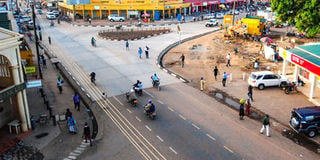Cabinet elevates 15 municipalities to cities

To be elevated. An aerial view of Arua Town with improved roads and housing facilities in the central business district. PHOTO BY CLEMENT ALUMA
What you need to know:
- The first lot has Arua, Gulu, Jinja, Fort Portal and Mbarara.
KAMPALA. The first five of the 15 cities that the Cabinet approved on Monday will start operations in July 2020, Ministry of Local Government has confirmed.
“We have set aside a budget of Shs130b to operationalise [to make operational] the cities, with the first lot starting operations in July 2020,” Col Tom Butime, the minister of Local Government, said yesterday.
The first lot has Arua, Gulu, Jinja, Fort Portal and Mbarara. In the second cohort, Hoima and Mbale will be elevated in 2021, while Lira and Entebbe will be in the third lot of the elevation. Others are Nakasongola, Moroto, Masaka, Soroti, Kabale and Wakiso.
While presenting the list of the cities yesterday, Col Butime said all the cities will be managed by the Ministry of Local Government.
Col Butime said the nine municipalities meet all the minimum requirements to be elevated to a city status, and will be upgraded in phases.
“As part of the overall effort to fast track Uganda into middle income status government has approved creation of 15 cities and their operationalisation is phased. Arua, Mbarara, Fort Portal and Gulu will start operations in July 2020, Hoima and Mbale will start in 2021, while Lira and Entebbe will come on board in 2022. Nakasongola, Moroto, Masaka, Soroti, Kabale and Wakiso will start operations in 2023,” Col Butime said.
He said the ministry is now developing guidelines for the operations of the approved cities. According to him, the guidelines will help in running the administration of the cities.
“We shall sit down and give guidelines to these new cities on how they are going to operate because the only city we have is Kampala, which is a central government city. There has never been a city which is local government. Now there are going to be cities as local governments so we need to have very clear guidelines of operations,” he said.
Election of Members of Parliament
According to the directive from the Local Government, each city will have three MPs. Two will represent the divisions within the cities and one Woman MP, just like the district representatives.
Col Butime said the creation of the cities will not eliminate the districts, adding that the original districts would remain intact, while the cities will have their own administrative units.
For example, initially, the entire Arua District had passed a resolution to become part of Arua city. However, later, Vurra County decided that they would not be part of the district, but would opt to be a district of their own. If the decision goes through, Arua District will cease to exist, metamorphosing into Arua City.
The minister said a city like Arua will have one representative for Arua Central, which is the current municipality, and another one representing Ayivu Division.
“We have divided them into two divisions, each division will have an MP, and just like the district, the third MP will be the Woman MP, to add the numbers to three,” he said.
He said all the new municipalities will have equal numbers of legislators to represent them.
On the boundary issues, Col Butime said all the issues regarding the boundaries between the divisions, cities and the mother districts have already been resolved.
He said prior to presenting the list of the cities to the Cabinet for approval, the commissioner for urban development was tasked to ensure that the issues are resolved and presented a clean bill of health.
“You know before we went to the Cabinet, the commissioner for urban administration went back to all those proposed cities and made sure that there was no debate or quarrel over those boundaries. As I talk now, we were in Cabinet last night, there was no misunderstanding over the boundaries, it is very clear. We made sure there was no going back to mark the boundaries of those divisions of the cities,” he said.
Other administrative units
The minister also said a number of other administrative units have also been created to create closer service delivery points to the people.
He said over the last three years, government has operationalised the creation of 23 districts that were approved before the 2016 elections. The remaining districts that did not start operations will effective July 1, this year become districts. They include; Rwampara, Karenga, Obongi, Kalaki, Kitagwenda, Kazo and Madi Okollo districts. Terego District will start operations in 2020, according to the minister.
The minister said overall, the ministry has completed 62 per cent of the manifesto promises and is on course to score 100 per cent by the end of this year, or early next year.
“To this end, the ministry has already realised 62 per cent of the manifesto commitments and remains committed to achieving 100 per cent by completing construction of markets, improving staff levels, conducive environment and scaling up resources transferred to the local governments,” he said.




